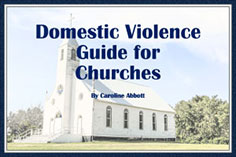
Abuse victims are encouraged by everyone to leave their abusers for their own safety, and the safety of their kids. During their divorces, however, they are told they must give partial, or sometimes even full-custody of their kids to their abuser.
This is just not right.  Tweet This
Tweet This
Like these women,* I also had to fight my abuser in court for custody of my kids. Click here for my story. After a year and a half of divorce proceedings, my abuser received week-on, week-off parenting time, and we were told we should “co-parent,” and have joint decision-making for our kids. When the judge (a woman!) gave this ruling, I cried harder than I ever have before or since. I was shocked that any judge, particularly a woman, would make such a ridiculous ruling. If I could “co-parent” with my abuser, I wouldn’t have needed a restraining order and a divorce!
This is a topic I am very passionate about. Here are the many other blogs I’ve written about how the court system (mis)manages DV cases. This situation burns me up. Recently, DomesticShelters.org wrote an article about this situation, and what is being done to change this lunacy.
Initiative for Change
In 2013, the Department of Justice’s Office on Violence Against Women, in partnership with the National Council of Juvenile and Family Court Judges, funded a two-year initiative called the Family Court Enhancement Project (FCEP). FCEP selected four court systems across the country to review how custody related issues are dealt with when domestic violence is present, and how things can be improved. The four courts selected were the Circuit Court of Cook County in Chicago, Ill.; Family Court of the State of Delaware; Hennepin County Family Justice Center in Minneapolis, Minn.; and Multnomah County Family Court in Portland, Ore.
Judge Anne Hirsch, one of the mentor judges working with the FCEP believes the current problems in family courts stem from a lack of resources and education. Many court system officials aren’t adequately trained in domestic violence, and DV survivors aren’t equipped to navigate complicated court systems. “Any judge I talk to wants to make the right decision,” says Hirsch. “It’s difficult to do that when we don’t get all the information.” She says both survivors and abusers will often minimize the abuse. “It’s got to be frightening for someone to come to court and tell a perfect stranger that your partner’s been abusing you and your children. You come to court for help but you are scared and don’t understand the process. So, one of the very early things we’re working on is how to improve the process for how people come in and share their story.”
That could mean simple things like:
- Changing rules so the survivor doesn’t have to sit with her abuser.
- Improving security measures so the survivor feels safer,
- Providing private places to fill out paperwork,
- Making sure that paperwork understandable, and
- Providing sufficient staff to help them.
Cook County’s Domestic Violence Division has already started making changes, like creating an “Expediter” position. The Expediter helps survivors explore safe parenting plans. Cook County created this job, “so that a parent can get help understanding what information a judicial officer needs to make a good, and safe, decision” says Hirsch.
Co-Parenting
DV advocates agree that co-parenting with one’s abuser is not a wise in most cases. Yet most judges rule in favor of fifty-fifty custody, even when domestic violence is present. These judges make decisions based upon evidence that says fifty-fifty custody is better for the children. The problem is, this evidence was gleaned from divorce cases where no domestic violence existed. To make meaningful changes,
Judges need to fully understand the domestic violence survivors have experienced, and survivors need to better understand how the court system works.  Tweet This
Tweet This
Before any court involved in the FCEP decided on changes they wanted to make, Hirsch says they had community-wide meetings that included court staff, judges, legal aid attorneys, victim advocates and other community partners to discuss the current practices and decide how best to make system improvements.
Spreading the Word
FCEP’s goal is to share these lessons and best practices with courts and communities across the country. To help accomplish this, a website of best practices is being created, and will go live sometime in 2017. “Lessons learned and best practices will be designed to be adjusted and adapted to whatever county you work within,” says Hirsch.
Eryn Jane Branch, overseer of the FCEP, says she believes many court systems nationwide will adopt elements of the project’s work quickly. She says making these changes in a court system is a huge project, but she is hopeful courts around the country will be interested in creating a safe place for survivors and their children. Click here to listen to the webinar given at the conclusion of the study done in Cook, County, Illinois.
Community Collaboration is Needed
Hirsch says up to half of all courts’ workloads involve family law cases, but because of financial challenges, custody cases with domestic violence don’t get enough attention. Hirsch believes, “Court systems need to prioritize resources for . . . custody cases. Courts can always improve, at little or no cost, how they collaborate with system partners—DV advocates, Child and Family Investigators, attorneys, treatment providers and others. When you’re working on an issue like domestic violence, history shows that community collaboration is the way improvements are made.”
Question: What is YOUR experience in Family Court? Did they judge your case fairly?
Proverbs 3:13 says:
Blessed are those who find wisdom,
those who gain understanding.
And, in John 7:24, Jesus exhorts us to:
Stop judging by mere appearances, but instead judge correctly.
Lord, I pray our courts will search for wisdom and understanding of domestic violence. I pray our judges will no longer judge by appearances, but will strive to judge correctly. Amen
Many blessings to you all,
Caroline
* Abusers can be both male or female, and so can their victims. In this blog, I portray the abuser as male and the victim as female.



I never even got my trial. He continues post separation abuse and everyone lets him. I don’t know how much more of this I can take. And my poor children. Please help!!!! Anyone? Does anyone hear me?
We hear you. It is criminal what happens in family court